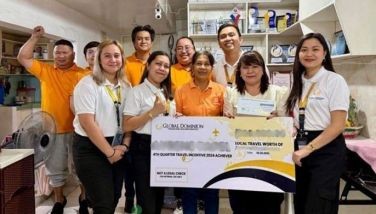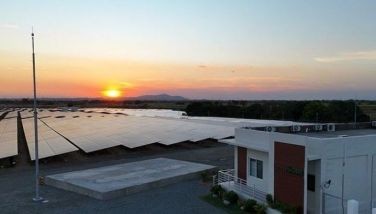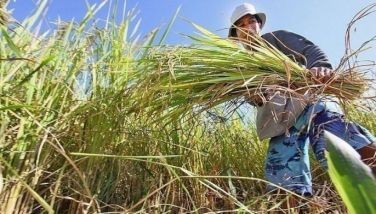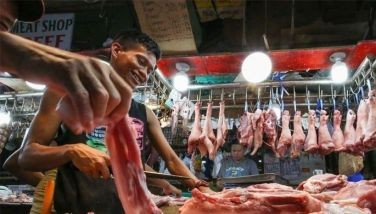The 4 B’s of Pangasinan
November 10, 2002 | 12:00am
DAGUPAN CITY — Pangasinan’s pride is summarized into four b’s: bangus, bagoong, bocayo and beaches.
However, one of these, the bocayo industry, is dying and needs all the resuscitation to make it alive and kicking again in the market.
Time was when a visit to Pangasinan relatives means eating with gusto Bonuan bangus (either sinigang, grilled or fried) dipped in bagoong made in Lingayen town and having dessert of several pieces of sweet and delicious bocayo (coconut candies) while enjoying the windy atmosphere in the clear waters of the province's beaches.
Fernando Tandoc, about 90 years old from Bacayao Sur, Dagupan City revealed to The STAR, that this old industry is believed to have originated in barangay Pangapisan, Lingayen. A tale of how bocayo started said that Ambrosio Tandoc, Fernando’s uncle, now deceased, courted a lady from Pangapisan whose family was into bocayo making.
Unluckily, he didn’t win her heart but he successfully copied the secrets of bocayo making because while he was trying to court her, he was helping in the house chores. Soon he started to establish the industry in his barangay. The rest, as folks say, was history.
Right now, aside from bocayo makers here, others are located in the towns of Lingayen and Calasiao. Bocayos for sale are conspicuously displayed in these markets and in the pilgrimage town of Manaoag. Others are marketed in Isabela, Cagayan and in Southern Tagalog.
For quite sometime, this remarkable coconut food processing industry thrived and it used to supply the demand in Luzon. Old folks say the ethnic and exotic taste of bocayo is preferred in the global market and thus must be exploited.
However, bocayo’s export was a mere 0.56 metric ton worth $2,000 freight-on-board (FOB) 2000, a far cry from the 24.83 metric tons worth $33,990 FOB as recorded by the (Trades and Market Administration Division of the PCA).
Experts agree that to save the bocayo industry, there is a need to institute quality control of raw materials, product reformulation packaging and labeling to insure a good product positioning in the global market.
With the presence of many other available sweets in the market today, bocayo makers are now developing other products similar to the procedures of making bocayo like pastillas and bocarilyo.
The province of Pangasinan covers a land area of 536,818 hectares which constitutes almost one-half (41.8 percent) of the total land area of Region I and 1.8 percent of the total area of the country.
One might wonder why Pangasinan boasts of its bocayo industry. Pangasinan, in fact is the number one coconut producer of Northern and Central Luzon. For decades, coconut farmers in the province used to process their produce into copra, until the early 80’s when the mode of marketing shifted to whole nut basis due to high demand and competitive price.
Coconuts are permanently planted to 19 municipalities beginning from the central up to the western towns. Coconuts abound in 162 barangays located mostly in coastal areas. Some sporadic plantings are found in the certain towns.
With an average of 34.68 nuts per tree per year, the province has an estimated annual yield of 20,291,268 million nuts. Produce are either marketed as "buko" or matured nuts. Seventy percent is sold as buko.
Bocayo and other kakanin makers absorb most of the matured nuts. Bocayo industry suffered when farmers shifted their marketable produce from matured to buko
Aware of this problem, the city government of Dagupan, the Philippine Coconut Authority (PCA) through Administrator Danilo Coronacion, the Department of Trade and Industry (Pangasinan Office) headed by Lucas and the Bocayo Makers Association of Dagupan City under Leonardo Hidalgo signed a memorandum of agreement to improve the existing bocayo industry for the local and international market. The gigantic step towards saving bocayo was made possible when no less than PCA Director Oscar Santos, former congressman of Quezon, came here more than a month ago to see for himself how the PCA could help.
Among the aims of the project are to improve the traditional bocayo processing through the standardization of raw materials specifications, determination of cooking, end-point and use of alternative ingredients such as flavorings, alternative sweeteners and dried fruits; to develop product packaging for market promotion and shelf-life extension; to conduct bench and pilot-scale production with the identified collaborator; to determine the nutritional value of the product; to establish product standards and to introduce good manufacturing practices
The PCA provided financial assistance of P150,000 while the private cooperator (Bacayao Bocayo Makers association) shall make available for PCA and DTI the use of its bocayo plants facilities and personnel for the attainment of the goal of this project and to commit P10,000 and to endorse to the city government and PCA the project's acquired packaging equipment for usage in another project after it has been able to procure its own equipment.
The Department of Trade and Industry shall be responsible in the trade promotion of the improved product especially in the conduct of its exhibition in the ASEAN Ethnic Food Festival on Nov. 22 at the PTTC, Manila. And the city government under Mayor Benjamin Lim shall provide counterpart-funding support for the implementation of the project study and to complement DTI in the trade promotion activities.
However, one of these, the bocayo industry, is dying and needs all the resuscitation to make it alive and kicking again in the market.
Time was when a visit to Pangasinan relatives means eating with gusto Bonuan bangus (either sinigang, grilled or fried) dipped in bagoong made in Lingayen town and having dessert of several pieces of sweet and delicious bocayo (coconut candies) while enjoying the windy atmosphere in the clear waters of the province's beaches.
Fernando Tandoc, about 90 years old from Bacayao Sur, Dagupan City revealed to The STAR, that this old industry is believed to have originated in barangay Pangapisan, Lingayen. A tale of how bocayo started said that Ambrosio Tandoc, Fernando’s uncle, now deceased, courted a lady from Pangapisan whose family was into bocayo making.
Unluckily, he didn’t win her heart but he successfully copied the secrets of bocayo making because while he was trying to court her, he was helping in the house chores. Soon he started to establish the industry in his barangay. The rest, as folks say, was history.
Right now, aside from bocayo makers here, others are located in the towns of Lingayen and Calasiao. Bocayos for sale are conspicuously displayed in these markets and in the pilgrimage town of Manaoag. Others are marketed in Isabela, Cagayan and in Southern Tagalog.
For quite sometime, this remarkable coconut food processing industry thrived and it used to supply the demand in Luzon. Old folks say the ethnic and exotic taste of bocayo is preferred in the global market and thus must be exploited.
However, bocayo’s export was a mere 0.56 metric ton worth $2,000 freight-on-board (FOB) 2000, a far cry from the 24.83 metric tons worth $33,990 FOB as recorded by the (Trades and Market Administration Division of the PCA).
Experts agree that to save the bocayo industry, there is a need to institute quality control of raw materials, product reformulation packaging and labeling to insure a good product positioning in the global market.
With the presence of many other available sweets in the market today, bocayo makers are now developing other products similar to the procedures of making bocayo like pastillas and bocarilyo.
The province of Pangasinan covers a land area of 536,818 hectares which constitutes almost one-half (41.8 percent) of the total land area of Region I and 1.8 percent of the total area of the country.
One might wonder why Pangasinan boasts of its bocayo industry. Pangasinan, in fact is the number one coconut producer of Northern and Central Luzon. For decades, coconut farmers in the province used to process their produce into copra, until the early 80’s when the mode of marketing shifted to whole nut basis due to high demand and competitive price.
Coconuts are permanently planted to 19 municipalities beginning from the central up to the western towns. Coconuts abound in 162 barangays located mostly in coastal areas. Some sporadic plantings are found in the certain towns.
With an average of 34.68 nuts per tree per year, the province has an estimated annual yield of 20,291,268 million nuts. Produce are either marketed as "buko" or matured nuts. Seventy percent is sold as buko.
Bocayo and other kakanin makers absorb most of the matured nuts. Bocayo industry suffered when farmers shifted their marketable produce from matured to buko
Aware of this problem, the city government of Dagupan, the Philippine Coconut Authority (PCA) through Administrator Danilo Coronacion, the Department of Trade and Industry (Pangasinan Office) headed by Lucas and the Bocayo Makers Association of Dagupan City under Leonardo Hidalgo signed a memorandum of agreement to improve the existing bocayo industry for the local and international market. The gigantic step towards saving bocayo was made possible when no less than PCA Director Oscar Santos, former congressman of Quezon, came here more than a month ago to see for himself how the PCA could help.
Among the aims of the project are to improve the traditional bocayo processing through the standardization of raw materials specifications, determination of cooking, end-point and use of alternative ingredients such as flavorings, alternative sweeteners and dried fruits; to develop product packaging for market promotion and shelf-life extension; to conduct bench and pilot-scale production with the identified collaborator; to determine the nutritional value of the product; to establish product standards and to introduce good manufacturing practices
The PCA provided financial assistance of P150,000 while the private cooperator (Bacayao Bocayo Makers association) shall make available for PCA and DTI the use of its bocayo plants facilities and personnel for the attainment of the goal of this project and to commit P10,000 and to endorse to the city government and PCA the project's acquired packaging equipment for usage in another project after it has been able to procure its own equipment.
The Department of Trade and Industry shall be responsible in the trade promotion of the improved product especially in the conduct of its exhibition in the ASEAN Ethnic Food Festival on Nov. 22 at the PTTC, Manila. And the city government under Mayor Benjamin Lim shall provide counterpart-funding support for the implementation of the project study and to complement DTI in the trade promotion activities.
BrandSpace Articles
<
>
- Latest
Latest
Latest
March 26, 2025 - 3:46pm
By Dominique Nicole Flores | March 26, 2025 - 3:46pm
February 28, 2025 - 11:26am
By Dominique Nicole Flores | February 28, 2025 - 11:26am
February 24, 2025 - 6:28pm
By Dominique Nicole Flores | February 24, 2025 - 6:28pm
February 19, 2025 - 7:28pm
By Dominique Nicole Flores | February 19, 2025 - 7:28pm
January 10, 2025 - 11:00am
January 10, 2025 - 11:00am
Recommended





























